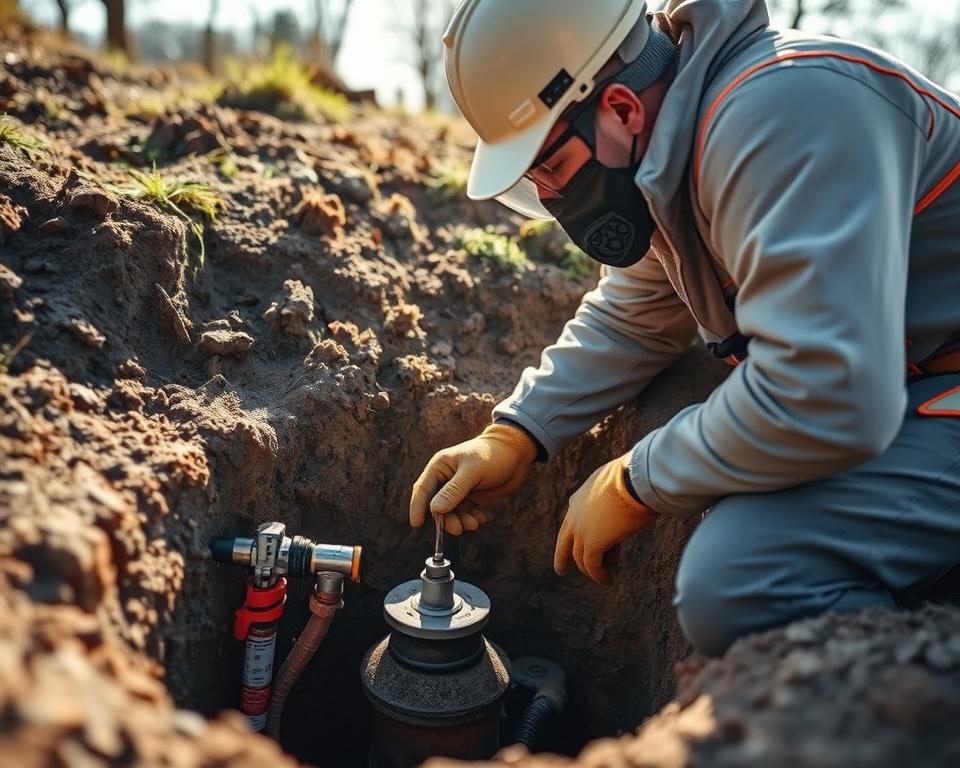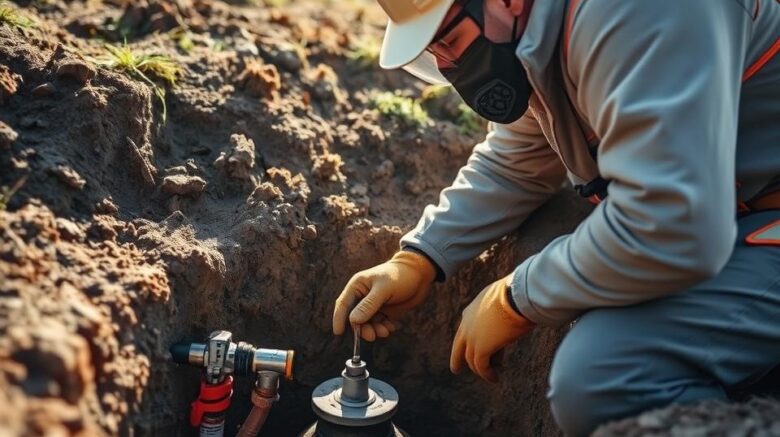Septic Pumping Cost Guide – Essential Info for Homeowners
Ever pondered the true expense of overlooking your septic system? Having a property with a septic system requires you need to appreciate the importance of routine maintenance. Understanding the prices of septic pumping and its price factors is crucial. That information can ward off a blockage and the nasty smells that come with it. We seek to enlighten homeowners on septic pumping’s benefit, pushing for proactive upkeep for a safe home environment.
Noteworthy Points
- Septic systems are vital for homes without municipal sewer connections.
- Regular maintenance can protect families from costly repairs.
- Septic pumping fees fluctuates based on various factors.
- Understanding septic tank pumping prices is vital for budgeting.
- Forward-thinking septic system maintenance promotes longevity and efficiency.
Septic Pumping Explained
Septic pumping clears out waste and sludge from a septic tank, vital for system efficiency. With time, solids settle at the tank’s bottom, requiring removal. This service helps avoid overflows and malfunctions. Appreciating septic pumping highlights its maintenance importance, hence septic pumping service.
Keeping a septic tank in top condition requires routine maintenance, including pumping. Generally, a tank requires attention every 3 to 5 years. Factors like tank size and household usage influence this schedule. Proper maintenance clears blockages and lengthens your system’s lifespan, avoiding pricey future repairs.
Elements Affecting Septic Pumping Cost
The cost of septic service ranges greatly, chiefly influenced by the tank’s size. Larger tanks demand more effort and resources for pumping, therefore, they are more expensive. Additionally, your geographical area plays a major role in determining costs. Prices in cities are higher due to the increased costs of labor and transport, whereas country regions might be cheaper.
The frequency of septic pumping is another essential factor, influenced by the household size and water usage. Big households or higher usage implies pumps are needed more often, increasing the costs. Also, any supplementary services required during pumping, like inspections or repairs, can boost the bill substantially.
Caring for your septic system is crucial to prevent emergency repairs, which are costly. Scheduled maintenance not only cuts expenses but also helps ensure your system remains efficient.
Average Cost to Pump a Septic Tank
The cost to pump a septic tank typically falls between $250 and $600. Most homeowners will invest close to $400. The price is influenced by the tank’s size, its location, and how often it needs maintenance. These factors help homeowners plan their budget for septic system upkeep.
| Tank Size (Gallons) | Average Pumping Cost ($) |
|---|---|
| 750 | 175 – 300 |
| 1,000 | 225 – 400 |
| 1,250 | 275 – 500 |
| 1,500 | 345 – 600 |
| 1,750 | 400 – 700 |
Bear in mind, inspection costs might push your total up by $100 to $250. Consistent upkeep can minimize these expenses. It cuts out the hefty fees associated with major repairs down the line.

Tank Size vs. Pumping Expense
The size of a septic tank greatly impacts the overall pumping cost. For instance, tanks with a 750-gallon capacity usually cost between $175 and $300 to pump. By contrast, a 1,750-gallon tank’s pumping fees can range from $400 to $700. This demonstrates the septic tank size impact on cost, highlighting how capacity influences maintenance expenses.
Higher water usage by a household means more frequent pumping, thus driving up expenses. A large family using more water will need pumping services sooner than a smaller one. By using a septic tank pumping cost estimator, homeowners can better plan for these costs. This tool includes septic tank size and its maintenance needs.
| Septic Tank Size (Gallons) | Pumping Cost Range ($) | Estimated Frequency of Pumping (Years) |
|---|---|---|
| 750 | $175 – $300 | 3 – 5 |
| 1,000 | $300 – $400 | 3 – 5 |
| 1,500 | $350 – $600 | 4 – 6 |
| 1,750 | $400 – $700 | 4 – 7 |
Knowing how tank size affects costs aids homeowners in making educated decisions. It enables effective management of septic systems and maintenance planning.
Regional Septic Pumping Price Comparison
Septic pumping costs differ substantially across the United States. The difference is driven by local labor rates, service demand, and cost of living. In rural areas, pumping services may cost as low as $200. Meanwhile, in urban areas, prices can climb from $400 to more than $800.
For a clearer understanding, the table below compares average septic pumping costs in various cities:
| City | Average Cost ($) |
|---|---|
| Philadelphia, PA | 265 |
| Charlotte, NC | 889 |
| Los Angeles, CA | 650 |
| Chicago, IL | 450 |
| Austin, TX | 375 |
Understanding the regional variances in septic tank pumping costs is important for homeowners. It arms them with the knowledge to make smart choices. By researching local prices, homeowners can select the most suitable service providers. This helps their septic systems are properly maintained.
Septic Pumping Frequency Recommendations
Grasping the correct frequency for septic pumping is vital for a well-functioning system. The Environmental Protection Agency recommends most tanks require service every three to five years. This guideline differs based on the size of your household and your daily water use.
For smaller homes with 1 to 3 people, pumping every 4 to 6 years may be adequate. However, families of 6 to 10 should consider more frequent servicing, perhaps every 2 to 4 years. Scheduling your septic tank pumping properly enhances its efficiency greatly.
Slow drainage or sudden sewage backups warn of impending pumping needs. Maintaining a routine check-up, while following professional advice, supports the system healthy. Such precautions deter costly repairs in the future.
Supplementary Septic Fees
Thoughtful cost management is essential for septic system upkeep due to several cost factors. Beyond standard pumping, you must consider other service fees that may surface during regular checks. Routine inspections are vital for maintaining the system’s health, averaging around $300. These spot issues early, heading off major problems.
Unforeseen services can be pricey. For example, removing a clog might cost up to $1,700. Such expenses significantly affect the maintenance budget. Additionally, field aeration, crucial for the system’s efficiency, can cost between $10,000 and $20,000. This represents a substantial investment in the system’s longevity.
Maintenance tasks like filter cleaning also entail varying costs, between $100 and $1,000. These expenses form part of the overall budget for septic upkeep. Homeowners should anticipate for these costs. Being aware of these potential charges helps ensure your septic system operates efficiently.
Budget-Friendly Pumping Tips
Homeowners in search of cost-effective septic pumping solutions have a variety of strategies at their disposal. One effective step is to request quotes from multiple providers. This reveals the going rates and find attractive offers. Companies close by, like All in Sanitation, might offer benefits for local residents, potentially reducing costs.
Choosing to schedule maintenance during the off-peak seasons can lead to substantial savings. It’s a smart move to look into bundling options, as they often come with extra discounts. Keeping an eye out for the latest promotions and available deals on septic services can greatly reduce the upkeep costs.
Importance of Hiring a Professional for Septic Pumping
Hiring a professional for septic pumping is crucial for safety and the system’s peak performance. These experts have advanced knowledge and the latest equipment for thorough septic care. Attempting to pump a septic tank without the right skills can expose individuals to dangerous methane gas.
Professional septic services make sure your system meets local waste disposal regulations. This compliance is important for public health and protecting the environment. With growing environmental concerns, opting for licensed and experienced septic services is imperative.
When scheduling maintenance, consider these important factors:
- Expertise in handling different septic systems
- Access to specialized tools and technology
- Knowledge of local laws and regulations
- Ability to detect potential issues before they escalate
- Proficiency in efficient waste disposal methods
Understanding the Importance of Regular Maintenance
Consistent upkeep of septic systems is crucial to avoid expensive repairs and failures. It helps that these systems function well over time. Without proper upkeep, major issues like backups and leaks may occur, necessitating high-cost fixes.
Periodic inspections and adherence to pumping schedules significantly boost septic systems’ longevity. This ongoing maintenance not only minimizes the risk of wear but also promotes eco-friendly living. Homeowners then benefit from the certainty that their systems are dependable, shielding both their financial investment and health.
The Final Word
For homeowners using septic systems for waste management, understanding their upkeep is essential. Exploring the costs of septic pumping clarifies the financial aspect of system maintenance. By ensuring routine maintenance and proper pumping, hefty surprises can be avoided, supporting the system’s longevity.
We covered the factors that affect pricing, explored regional cost variations, and emphasized the necessity of maintenance. Following these recommendations and using professional guidance enables homeowners to effectively manage their septic systems. This delivers safe and long-lasting functionality.
Beyond mere regulatory compliance, forward-thinking care of your septic system improves your home’s health and protects the environment. By making well-considered decisions on maintenance, homeowners can secure a seamless and worry-free experience.
